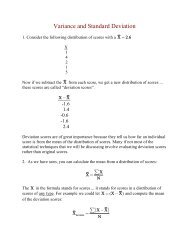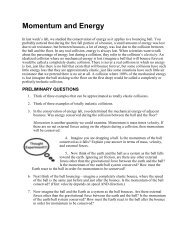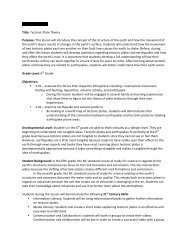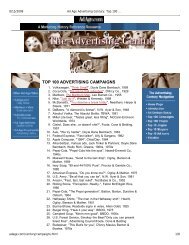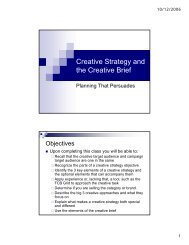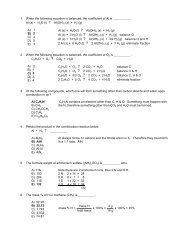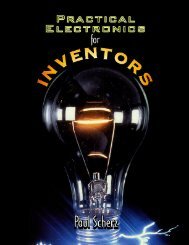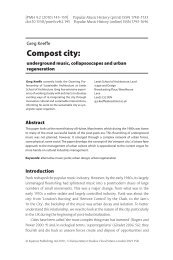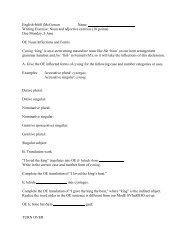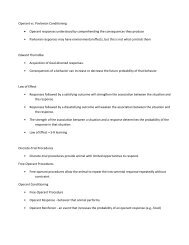SELF TEST EIGHT: HYPOTHESIS TESTING
SELF TEST EIGHT: HYPOTHESIS TESTING
SELF TEST EIGHT: HYPOTHESIS TESTING
Create successful ePaper yourself
Turn your PDF publications into a flip-book with our unique Google optimized e-Paper software.
<strong>SELF</strong> <strong>TEST</strong> <strong>EIGHT</strong>: <strong>HYPOTHESIS</strong> <strong>TEST</strong>ING<br />
1. List the formal steps in hypothesis testing.<br />
In questions 2 - 7, state the appropriate null and alternative hypotheses and find the critical z value<br />
for the test. In each case, assume that the population standard deviation is known.<br />
2. A Belchfire dealership will be feasible in Kasuthville if average family income in K-ville is at least<br />
$60,000 a year. We wish to survey a sample of K-ville families to determine the feasibility of placing a<br />
dealership there; we will test at α = 0.05.<br />
3. We are arranging a lab test for our new drug, and we wish to be able to certify, at 8% significance, that<br />
capsules on average contain no more than 5 parts per billion of impurities.<br />
4. Letter-Rip is an imitation of the famous Assimilate spreadsheet; Letter-Rip’s distributor claims that on<br />
average Letter-Rip recalculates spreadsheets in the same time as Assimilate. We have a set of<br />
spreadsheets for which the average recalculation time with Assimilate is known to be 12 seconds. We<br />
would like to test LR’s claim at 2% significance (α = 0.02).<br />
5. Engineers believe that a synthetic oil will reduce engine wear. With existing oils, bearing surfaces wear<br />
down by 0.5 mm in 500 hours of operation. State the appropriate null and alternative hypotheses to test<br />
whether the synthetic reduces wear; we want α = 0.1.<br />
6. Pop’s Deli sells hamburger guaranteed to be no more than 10% fat. Pop wants to set up an ongoing test<br />
procedure to ensure that he meets his guarantee, but since lean meat is expensive, Pop wants to be sure<br />
that he doesn't have less than 10% fat either. Pop wants to test at 10% significance (α = 0.1).<br />
7. To be successful, a new TV show must capture at least 30% of its prospective market. To test a new<br />
show being offered, a TV network will show it to a sample audience and observe the proportion in the<br />
sample who like the show. The network wants to conduct its test at 2% significance (α = 0.02).<br />
8. We want to test whether our Yuppie’s-n-cream ice cream is on average at least 34% butterfat, so we<br />
have H 0 : μ ≥ 34% with H 1 : μ < 34%. For all such ice cream the standard deviation of butterfat content<br />
= 1%, and the distribution among packaged quarts is known to be normal. We have a sample of 23<br />
quarts of Y-n-c, and we wish to test at α = 0.05. In our sample, the mean butterfat content is 33.7%.<br />
What is the p-value of the test Should we reject H 0 Bonus: What value of butterfat content would<br />
cause us to reject H 0 <br />
9. West Coast Wood is producing chopsticks for export to Japan; their customer specifies that the<br />
chopsticks are to average 17 cm. in length. Over time, West Coast has found that the length of their<br />
chopsticks is normally distributed with σ = 0.75 cm. From a new lot of chopsticks, a sample of 22 are<br />
drawn. We will run a two-tailed hypothesis test on them with α = 0.1. If⎯x = 17.2, does WCW need to<br />
adjust their machinery What is the p-value of this test<br />
10. Senator Fudd thinks it may be worth making a run for the Presidency if he can believe at 5%<br />
significance that at least 35% of the voters favor him already. So the senator's political pollsters<br />
conduct a survey of 1,132 registered voters to test the null hypothesis H 0 : π ≥ 0.35. If in the sample<br />
only 33% per cent favor Fudd, will running for President be worthwhile What are the standard error,<br />
the z value and the p-value of the test<br />
11. The Pay-less tax preparation firm claims to have an error rate of no more than 2%. To test this claim, a<br />
consumer information organization selects a sample of 600 tax returns prepared by Pay-less and<br />
examines them for errors; they will use the result to test H 0 : π ≤ 0.02 with H 1 : π > 0.02, and they wish to<br />
use α = 0.01. In the sample from Pay-less, the investigators find 21 incorrect returns. Should they<br />
accept or reject H 0 What is their conclusion about Pay-less’s claim
self-test 8, page 2<br />
12. Suppose that a null hypothesis to be tested is true. Then the probability of a rejection error (Type I<br />
error) is _________.<br />
13. If the null hypothesis is true, then β = _________.<br />
14. Other things being equal, as α increases, β ___________.<br />
15. For each of the following situations, state what a Type I error is, what a Type II error is and the likely<br />
costs associated with each.<br />
a) An earthquake may have damaged the grandstands at Candlestick Park; engineers will inspect the<br />
stadium seating with the hypothesis that the stadium has been damaged.<br />
b) Betsy the Buyer conducts a hypothesis test in deciding whether to buy a truckload of potatoes; her<br />
hypothesis is H 0 : μ ≥ 8 oz.<br />
c) Blue Moon Nightclub is willing to advertise in the Charlotte Daily Mullet Wrapper if they can be<br />
reasonably sure that at least 20% of the newspaper’s readers are under 35 years of age.<br />
d) Safety personnel are examining the remains of an airplane crash; their initial hypothesis is that the<br />
crash resulted from pilot error. If they’re convinced that was the cause, they’ll drop their<br />
investigation.<br />
16. In the following sketch, we are testing the hypothesis H 0 : μ ≥ 170. We will reject the null hypothesis<br />
whenever ⎯x < 135. On the sketch, indicate the area that represents α and the area that represents β.<br />
Show what will happen if the significance level is reduced; if it is increased.<br />
Calculating Beta<br />
45 60 75 90 105 120 135 150 165 180 195 210 225 240<br />
17. In designing a hypothesis test, if the cost of a Type I error is very high and that of a Type II error low,<br />
we would prefer to have a __________ significance level, since the probability of a Type I error is<br />
_______.<br />
18. Find the critical z values(s) for each of the following pairs of hypotheses and state the decision rule:<br />
a) H 0 : μ ≤ 80 vs. H 1 : μ > 80, α = 0.05<br />
b) H 0 : π = 0.65 vs. H 1 : π ≠ 0.65, α = 0.05<br />
c) H 0 : μ ≥ 112 vs. H 1 : μ < 112, α = 0.1<br />
d) H 0 : μ = 9000 vs. H 1 : μ ≠ 9000, α = 0.01<br />
19. Find the critical t value(s) for each of the following pairs of hypotheses:<br />
a) H 0 : μ ≤ 43 vs. H 1 : μ > 43 with n = 18 and α = 0.05.<br />
b) H 0 : μ = 57 vs. H 1 : μ ≠ 57 with n = 20 and α = 0.01.<br />
c) H 0 : μ ≥ 29 vs. μ < 29 with n = 28 and α = 0.025.<br />
d) H 0 : μ = 2001 vs. H 1 : μ ≠ 2001 with n = 12 and α = 0.05.
self-test 8, page 3<br />
20. ART engineers are trying to rearrange their production line, and they need to be sure that on average it<br />
takes no more than 12 minutes for assembly operation A. It is firmly believed that for processes of this<br />
type, the distribution of assembly times is normal. Thus, the engineers will test μ ≤ 12 min. with H 1 : μ<br />
> 12 min., and it is decided to conduct the test at 5% significance (α = 0.05). The engineers select a<br />
sample of 21 workers and have them perform the operation; for the workers in the sample⎯x = 12.19<br />
min. with s = 0.5 min. Should the engineers accept or reject the null hypothesis<br />
21. The Dean of Students at an urban university believes that students commute an average distance of 22<br />
miles and that commuting distance is approximately normally distributed.<br />
a) State the appropriate null and alternative hypotheses for testing the Dean's belief.<br />
b) The null hypothesis will be tested with a sample of 65 students; find the critical t values for tests at<br />
10% and 1% significance.<br />
c) In the sample ⎯x = 24 miles and s = 6 miles. Does this result confirm the Dean's belief<br />
22. In performing hypothesis tests about population means, the z distribution should be used in either of the<br />
following cases:<br />
a) whenever____________ is known and __________, regardless of sample size;<br />
b) or when ______ and the sample size __________, regardless of the shape of the population.<br />
23. The t distribution should be used in testing hypotheses about population proportions if the population<br />
standard deviation is ___________. For small samples we must also believe that the population is<br />
__________ distributed.<br />
24. The z distribution is always used in testing hypotheses about ___________.<br />
25. A sample of 23 records are drawn from a stockbroker's accounts and used to test the hypothesis that the<br />
average account is at least $28,000. The hypothesis is tested using the sample results ⎯x = $27,450 and s<br />
= $3,129; it is known that the distribution of all accounts is normal. What is the appropriate sampling<br />
distribution, or test statistic, to use in this test<br />
26. An academic advisor in the College of Business asserts that at least 40% of all students take Stats I<br />
more than once. This proposition is to be tested by drawing a sample of 200 student records and<br />
observing how many of those in the sample have taken the course more than once. In this test the<br />
appropriate test statistic is the _____________.<br />
27. Economic researchers have begun to look at workers’ expectations for wage increases, but they know<br />
little about the population distribution. The Bush Administration’s Council of Economic Advisors<br />
asserts that the current average expectation is for no more than a $700 increase next year. If this<br />
hypothesis is to be tested by interviewing a sample of 75 workers, the appropriate sampling distribution,<br />
or test statistic, to use is the ______.<br />
28. In the preceding question, suppose that for the sample of 75 workers,⎯x = $800 and s = $500. At 5%<br />
significance, should we accept or reject the null hypothesis implied by the Administration's claim<br />
29. In setting up an hypothesis test, ART's engineers discover that with a 5% significance level (α = 0.05),<br />
they have unacceptably large values for β for some possible values of μ. The engineers would in fact<br />
like to reduce α even further, preferably to 0.01. The only way out of their dilemma is ____________.<br />
30. In designing a hypothesis test, if the cost of a Type I error is very high and that of a Type II error low,<br />
we would prefer to have a __________ significance level, since the probability of a Type I error is<br />
_______.<br />
31. What three factors must be taken into account in designing a hypothesis test
self-test 8, page 4<br />
32. For each of the following hypothesis tests, find the p-value of the test and state whether the null<br />
hypothesis should be rejected at 5% significance level.<br />
a) We are testing H 0 : μ ≥ 20 vs. H 1 : μ < 20. The population standard deviation σ = 2; in a sample of<br />
size 36, the sample mean ⎯x = 19.2.<br />
b) We wish to test whether bottles of Sudso Liquid Detergent contain 40 oz of detergent. The process<br />
standard deviation is 6. In a sample of 28 bottles, the mean content is 42.7 oz.<br />
c) Government investigators wish to determine whether long-haul truckers are exceeding the federal<br />
standard of no more than 92 hours of driving in a two-week period, so H 0 : μ ≤ 92 with H 1 : μ > 92.<br />
The standard deviation of hours driven for all truckers is known to be 5 hours. In a sample of 32<br />
truckers, their logs show that in the previous two weeks they drove an average of 93.3 hours.<br />
d) Nationally, 70% of teenagers eat fast food at least once a week. We’d like to know whether the<br />
proportion is the same in Gopher Prairie. In a sample of 312 teenagers in Gopher Prairie, 65% eat<br />
out at least once a week.
self-test 8, page 5<br />
<strong>SELF</strong> <strong>TEST</strong> <strong>EIGHT</strong>:<br />
1. see notes<br />
2. H 0 : μ ≥ 60,000<br />
H 1 : μ < 60,000; −1.64<br />
3. H 0 : μ ≤ 5<br />
H 1 : μ > 5; +1.41<br />
4. H 0 : μ R = μ L<br />
H 1 : μ R ≠ μ L ; ±2.33<br />
5. H 0 : μ ≥ 0.5, that is, wear is at least .5 mm<br />
H 1 : μ < 0.5; −1.28<br />
6. H 0 : μ = 10%<br />
H 1 : μ ≠ 10%; ±1.64<br />
7. H 0 : π ≥ 0.3<br />
H 1 : π < 0.3; −2.05<br />
8. no, p-value = 0.0749; less than 33.66%<br />
9. no, z=1.25 p-value = 0.211<br />
10. On Fudd’s criteria, he should run. σ p =1.4176 (or 0.01476), z= −1.41, p-value=0.0793<br />
11. reject since p-value = 0.0044; error rate is higher than claimed<br />
12. =α<br />
13. 0<br />
14. decreases<br />
15.<br />
16.<br />
17. low; significance level or α<br />
18. +1.64, reject null if z > 1.64; ±1.96, reject null if z < −1.96 or z > +1.96; −2.33, reject null if z <<br />
−2.33; ±2.58, reject null if z < −2.58 or z > +2.58 .<br />
19. +1.74; ±2.681;−2.052;±2.201<br />
20. reject;t=1.741>t C =1.725<br />
21.<br />
a) H 0 : μ = 22, H 1 : μ ≠ 22;<br />
b) ±1.669 & ±2.655<br />
c) no, reject H 0 with t = 2.687<br />
22.<br />
a) pop. σ is known and the population is normally distributed<br />
b) pop. σ is known; n ≥ 30<br />
23. not known; normally<br />
24. proportions<br />
25. t<br />
26. z<br />
27. t<br />
28. reject; t=1.732>1.666.<br />
29. increase the sample size<br />
30. low; the significance level of the test<br />
32. a. 0.0082; reject H 0 :<br />
b. 0.0174; reject H 0 :<br />
c. 0.0708; do not reject<br />
d. 0.0536; do not reject



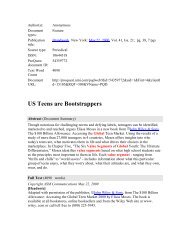

![Graduate Bulletin [PDF] - MFC home page - Appalachian State ...](https://img.yumpu.com/50706615/1/190x245/graduate-bulletin-pdf-mfc-home-page-appalachian-state-.jpg?quality=85)
